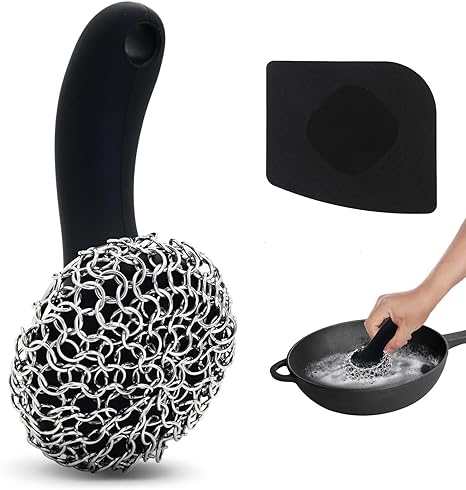<- Return to the ultimate cast iron skillet guide
As someone who’s been using cast iron cookware for years, I can tell you that seasoning cast iron is both an art and a science. If you do it right, you’ll have a skillet that lasts a lifetime (and maybe even more!). However, making a mistake during seasoning can lead to a sticky, uneven surface, or worse, rust! Over time, I’ve made my fair share of seasoning blunders, but I’ve also learned a lot. So, if you’re ready to start seasoning your cast iron cookware—or if you’ve run into trouble along the way—this guide will help you acheive results like a pro.
Why Seasoning Cast Iron Matters
Let me share why seasoning cast iron properly is so important. Seasoning is essentially the process of bonding oil to the surface of the cast iron, creating a slick, non-stick coating that improves over time. Unlike other pans that use chemical coatings, cast iron develops a natural non-stick surface when you cook with oils or fats. I remember the first time I properly seasoned a cast iron skillet—it was awesome. Suddenly, even delicate foods like eggs wouldn’t stick, and the pan just looked more beautiful each time I used it.
Preparing Your Skillet For Seasoning
The first step will be to prepare your skillet for seasoning. The preparation technique will vary based on whether you are seasoning a new pan, trying to revive the seasoning on a pan that you have already been using.
How To Prep New Cast Iron Cookware
Out of the box, your new skillet still needs minimal prep. Rub your fingers around the surface looking for any raised, rusted, or rough spots that may have been left behind by the manufacturing process. If found, any of these minor defects can be smoothed out by gently rubbing the surface with steel wool, a wire brush, or a cast iron scrubber specifically designed for cast iron.
The key is to not be overly aggressive with this step. If you apply too much pressure you will create grooves in the pan that will make a non-stick finish difficult to acheive.
How To Prep Cast Iron For Re-Seasoning
Sadly, there could a time where it makes more sense to start from scratch. This could be because you stored or initally made a mistake when initally seasoning cast iron, didn’t clean it properly, or cooked something in it that ruined the seasoning.
The good news is that the process of seasoning cast iron can be pretty forgiving. Prepping the skillet is fairly similar to what you would do for a new pan….it just might require a little more elbow grease on your part.
You will want to strip as much of the existing finish as you can. Steel wool works well for this, but I prefer to use a dedicated cast iron scrubber. This type of scubber has a handle that is far easier to use that steel wool, and makes it easier to apply the downward pressure needed to the skillet get back down to bare metal.
The key is to not be overly aggressive with this step. If you apply too much pressure you will create grooves in the pan that will make a non-stick finish difficult to acheive.
For a gentler cleaning, there are plant based cast iron scrubs that can help you strip the skillet without the risk of damaging the pan.
Now That The Pan Is Prepped
Do: Clean And Dry Your Skillet Before Seasoning Cast Iron
At this point it is OK to wash the pan in soap and water. The key is to use a plant based soap before you continue.
Plant based soaps do not have the harsh chemicals and perfumes that standard dish soap has. Remember, cast iron is pourous, so any of these chemicals or perfumes may actually be absorbed by your skillet and transfer into your food.
Once you’re done washing the pan, you need to dry it. The first step is to towel dry it inside and out (including the handle), and then heat it up on a burner on low heat for a minute or two.
Now It’s Time To Oil Your Cast Iron Cookware
Do: Apply A Thin Layer Of Oil
Heat the skillet over low heat for a minute or two to open up the pores of the metal. This helps the oil absorb into the skillet. I like to use a paper towel or cloth to rub oil all over the pan, inside and out (including the handle). Then, I wipe off any excess so that only the thinnest film remains.
For the best results, stick to oils with high smoke points like flaxseed oil, grapeseed oil, or vegetable oil, which will create a smooth, durable layer when seasoning your cast iron. There are also oils specifically designed for cast iron.
Seasoning cast iron with too much oil is never good…..a little oil goes a long way!
Don’t: Use Too Much Oil
Using either the wrong oil, or too much oil will likely not yield good results. Using too much oil will make your skillet sticky and gross looking. Some oils or fats may also turn rancid and should be avoided.
Finish In The Oven
After applying the oil, it’s time to bake it in. I preheat my oven to around 450°F and place the skillet upside down on the middle rack. Make sure to put a baking sheet or foil on a lower rack to catch any drips. The key is to let the skillet bake for about an hour, which allows the oil to bond with the cast iron and form the coveted protective layer that only properly seasoning cast iron can provide.
Once an hour has passed, turn off the oven and leave your cast iron skillet to cool inside the oven. After it cools to room temperature, your first seasoning layer should now be complete!
Do: Repeat the Process Multiple Times
Seasoning cast iron once is a good start, but to build up a long-lasting, non-stick surface, you’ll need to repeat the process several times. When I first started seasoning cast iron, I used to do it once and call it a day. But with time, I realized the magic happens when you add layer upon layer of seasoning.
After the first round of seasoning, let the pan cool, apply another thin layer of oil, and bake it again for another hour. Repeat this at least three times if your pan is brand new or needs serious restoration. You’ll notice that with each round, the surface becomes smoother and shinier.
Don’t: Forget to Maintain the Seasoning
After you’ve gone through the effort of seasoning cast iron, you want to keep it in good condition. One of the things I used to do wrong was to let my cast iron air dry after washing. Big mistake! Even the smallest amount of moisture can cause rust to form. These days, after every use, I rinse the skillet with warm water (no soap), dry it thoroughly with a towel, and then heat it briefly on the stove to ensure it’s completely dry.
After that, I rub a light layer of oil over the surface to maintain the seasoning. It’s a quick step that keeps the skillet in tip-top shape. I also avoid cooking acidic foods (like tomato sauce) in my cast iron for long periods, as this can erode the seasoning.
Do: Be Patient
If there’s one thing I’ve learned over the years, it’s that seasoning cast iron is a process that requires patience. Your skillet won’t become perfectly non-stick overnight, but with regular use and maintenance, it will improve. I remember the first time my skillet truly became non-stick after months of use—it was a rewarding moment, and I felt like I had earned it!
Don’t: Use Soap to Clean a Newly Seasoned Skillet
A final “don’t” that I learned the hard way: Never, ever use soap on a newly seasoned skillet! Soap strips away the seasoning you’ve worked so hard to build. Early on, I mistakenly cleaned my cast iron with dish soap, thinking it wouldn’t hurt since the seasoning had set. Wrong. My beautiful non-stick surface was gone, and I had to start from scratch. Stick to water and a soft scrub brush for cleaning, and save the soap for when your pan really needs a deep clean (which should be rare if you maintain it well).
Final Thoughts
Seasoning cast iron cookware might seem daunting at first, but once you understand the process and avoid the common pitfalls, it becomes second nature. The key is to start with a clean pan, apply just the right amount of oil, and bake it at a high temperature. With a little bit of patience and care, your cast iron skillet will reward you with years of non-stick cooking and durability.
Whether you’re new to cast iron or just looking to perfect your technique, the process of seasoning cast iron is well worth the effort. It transforms a simple skillet into a kitchen powerhouse, capable of making everything from perfectly seared steaks to deliciously crispy cornbread. Trust me—once you get the hang of properly seasoning cast iron, you’ll never want to go back to non-stick pans again.
Products That You May Find Useful When Seasoning Cast Iron:

Cast Iron Scrubber
Plant Based Soap For Cast Iron
Plant Based Cast Iron Scrub
Plant Based Cast Iron Oil

Cast Iron Care Combo Pack
Best Savings!

